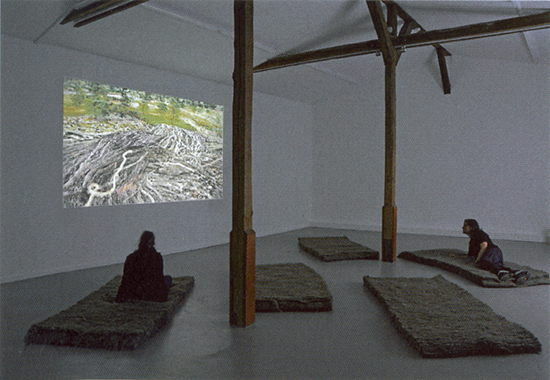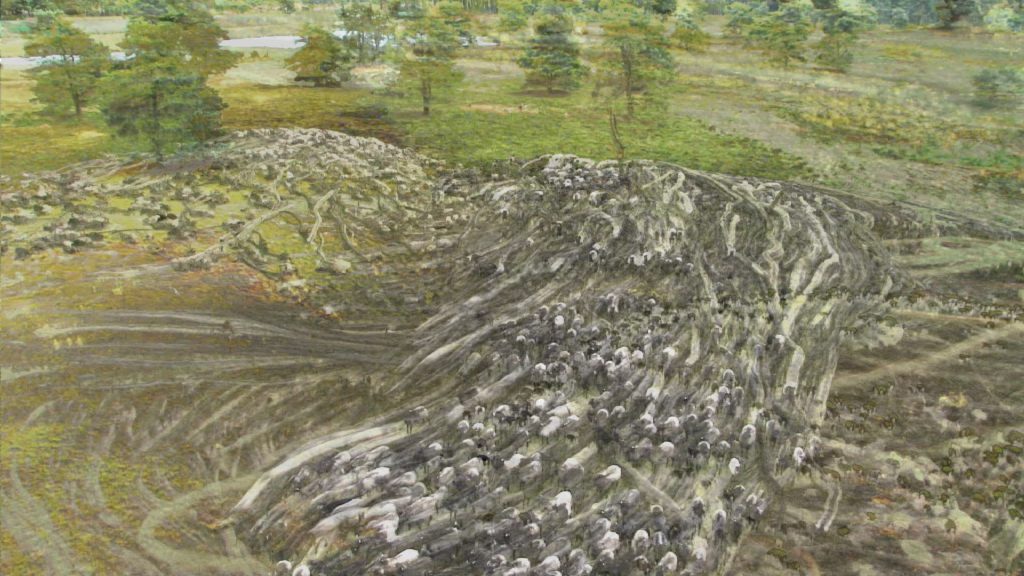
Installation at “Springhornhof” as part of the exhibition “Landscape 2.0”
The video installation “598” comprises a high definition video installation, digitally manipulated sound and five mats made of unprocessed sheep’s wool (42′ video stream gained from a custom made software).
“598” shows a landscape of primitive heathland, filtered through computer software operating without our knowledge or powers of interpretation. As if in our mind’s eye, a kind of landscape of the perceived image builds up. In their movements sheep are oriented not just to the group, but also in relation to the supply of food beneath them. The movements of individual animals, as well as of flocks as a whole, thus tell us about the composition of the landscape. The image is in itself already an interpretive vision of the soil beneath their feet which, over the centuries, has been used as pasture in the same way.
The form of the Lüneburg Heath already shows the effects of grazing sheep. Their consumption of grass and young shoots protects the heath from afforestation and creates clearings and open, green spaces; in other words, a heath. The appearance of freely grazed areas has, over the centuries, allowed a landscape to develop whose form derives from this symbiosis. But it is possible to recognize other forms of co-operation as well, and the sheep, which lack a sense of will, are a rewarding example for illustrating the study of behavioural strategies that go beyond egotism.
It is now not enough for us humans simply to observe and to learn to understand. In the computer we have designed a tool which grazing sheep, and a calming landscape, analyse and categorize by means of a structure that is capable of learning. This software learns from the landscape and from the 598 sheep – recorded on a video camera mounted on a crane, as if we humans, looking down from the clouds, were omniscient.
A new, artificial landscape develops which allows the properties of the things observed to be perceived. Due to the movement of the sheep across the heath these properties can be recognised but as individual images they are not evident.
Die Lüneburger Heide zeigt in ihrer Gestalt bereits die Auswirkungen der Schafe. Ihr Fressen von Gras und Schößlingen bewahrt die Heide vor der “Verwaldung”, schafft Lichtungen und Grünflächen, eben eine “Heide”.
Das entstehen von freigefressenen Terrains hat so über die Jahrhunderte eine Landschaft entstehen lassen, die ihre Gestalt aus dieser Symbiose herleitet. Aber nicht nur dieses Zusammenspiel ist erkennbar, die willenlosen Schafe sind ein dankbares Anschauungsbeispiel, um kollektive Handlungstrategien jenseits von Egosimen zu studieren.
Nun reicht es uns Menschen ja nicht, einfach hinzuschauen und verstehen zu lernen. So haben wir im Rechner ein Werkzeug entworfen, die weidenden Schafe und die ruhende Landschaft durch eine lernfähige Struktur zu analysieren und kategorisieren. Diese Software lernt von der Landschaft und von 598 Schafen – aufgenommen von einer Videokamera auf einem Kran, so als wären wir Menschen allwissend aus einer Wolke schauend.
Es entsteht eine neue, künstliche Landschaft, die es ermöglicht, Eigenschaften des Gesehenen wahrzunehmen, die aufgrund der Bewegungen der Schafe durch die Heide erkennbar werden, aber im Einzelbild nicht offensichtlich sind.

zur Software:
Die bishergie Software berechnet Differenzbilder vom aktuellen Bild eines Videos zu einem Referenzbild, um so Bewegungen fest zu stellen. Sie enthält weiterhin eine Art neuronales Netz, dessen Neuronen sich einzeln an die Differenzwerte jedes einzelnen Bildpunktes anpassen. Jeder Bildpunkt entspricht einem Neuron. Diese Software soll weiter entwickelt werden, so dass jedes Neuron nicht nur einzeln für sich den ihm zugewiesenen Bildpunkt lernt. Es sollen zusätzlich die Nachbarschaftsbeziehungen sowohl der Bildpunkte als auch der Neuronen mit einfließen. Dadurch entsteht ein selbst organisierendes System, Neuronen, die schon bestimmte Differenzwerte gelernt haben, fühlen sich zu ähnlichen Werten stärker angezogen. Sie lernen diese stärker mit. Somit werden sich Bereiche innerhalb des neuronalen Netzes ausbilden, die einerseits ähnlichen Differenzwerten entsprechen andererseits aber auch immer noch an den Ort der jeweiligen Bildpunkte gebunden sind.
August 2009
Programmierung: Matthias Weber, Sebastian Stang
Sound: Maximilian Netter, Sebastian Stang